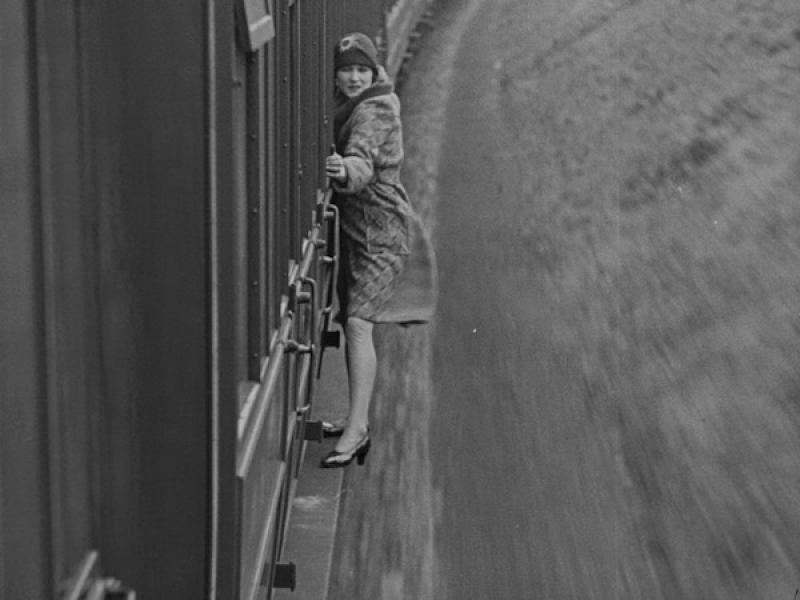DVD: The Flying Scotsman (1929) | reviews, news & interviews
DVD: The Flying Scotsman (1929)
DVD: The Flying Scotsman (1929)
The locomotive movie which inspired The Lady Vanishes and The 39 Steps

It is, of course, a masterpiece - not Castleton Knight’s primitive 1929 British talkie, but Sir Nigel Gresley’s LNER Class A3 4472 Flying Scotsman, which iconic steam locomotive is currently being refurbished for commissioned runs in the spring. It enjoyed its inaugural London-Edinburgh journey on 1 May, 1928, and so excited the public that it generated a silent comedy-thriller, to which sound was added in 1930.
Moore Marriott, best known as Will Hay’s ancient foil in the railway classic Oh, Mr Porter! (1937) and other Hay comedies, plays Old Bob, a 30-year veteran driver of the express service (which started in 1862). The day before retiring, he shops his stoker Crow (Alec Hurley) for drinking on duty. His place is taken by jeering rookie footplateman Jim (24-year-old Ray Milland in his debut), who the night before Bob’s final run is rescued from a dancehall fracas by the driver’s daughter, Joan (Pauline Johnson), though neither knows the other’s identity; kisses ensue. That this refined beauty was sitting alone in what looks suspiciously like a clip joint adds unintended frisson.
With the Scotsman hurtling north the following day, Bob bashes Jim on the head after discovering he's Joan's lover, while vengeful saboteur Crow sets up a catastrophe. There’s amazing stunt work by Johnson - in cloche and high heels! - and Hurley edging along the outside of a carriage that shames the back-projected Robert Donat (on the Scotsman) and Michael Redgrave in Hitchock’s The 39 Steps and The Lady Vanishes respectively. (Those are just two entries in the school of 1930s British train films that The Flying Scotsman partly inspired.)
Knight, who later produced documentaries about the 1948 Olympics and the Queen’s Coronation, made expressive transitional use of steam and dissolves. He was blessed by his collaboration with Theodor Sparkuhl, a former Eastern Front newsreel cameraman who had shot many of Ernst Lubitsch’s Berlin silents before heading to Hollywood via England. His use of trackside low-angles, long shots of the speeding train and close work in, around and under the cab makes The Flying Scotsman a must for train buffs, though its appeal is general.
The DVD release of this exquisitely restored picture follows its premiere at the Glasgow Film Festival last Saturday. Sadly, there are no extras.
Watch a clip from the restored film
Explore topics
Share this article
The future of Arts Journalism
You can stop theartsdesk.com closing!
We urgently need financing to survive. Our fundraising drive has thus far raised £49,000 but we need to reach £100,000 or we will be forced to close. Please contribute here: https://gofund.me/c3f6033d
And if you can forward this information to anyone who might assist, we’d be grateful.

Subscribe to theartsdesk.com
Thank you for continuing to read our work on theartsdesk.com. For unlimited access to every article in its entirety, including our archive of more than 15,000 pieces, we're asking for £5 per month or £40 per year. We feel it's a very good deal, and hope you do too.
To take a subscription now simply click here.
And if you're looking for that extra gift for a friend or family member, why not treat them to a theartsdesk.com gift subscription?
more Film
 Urchin review - superb homeless drama
Frank Dillane gives a star-making turn in Harris Dickinson’s impressive directorial debut
Urchin review - superb homeless drama
Frank Dillane gives a star-making turn in Harris Dickinson’s impressive directorial debut
 Mr Blake at Your Service review - John Malkovich in unlikely role as an English butler
Weird comedy directed by novelist Gilles Legardinier
Mr Blake at Your Service review - John Malkovich in unlikely role as an English butler
Weird comedy directed by novelist Gilles Legardinier
 Don't Let's Go to the Dogs Tonight review - vivid adaptation of a memoir about a Rhodesian childhood
Embeth Davidtz delivers an impressive directing debut and an exceptional child star
Don't Let's Go to the Dogs Tonight review - vivid adaptation of a memoir about a Rhodesian childhood
Embeth Davidtz delivers an impressive directing debut and an exceptional child star
 One Battle After Another review - Paul Thomas Anderson satirises America's culture wars
Leonardo DiCaprio, Teyana Taylor, and Sean Penn star in a rollercoasting political thriller
One Battle After Another review - Paul Thomas Anderson satirises America's culture wars
Leonardo DiCaprio, Teyana Taylor, and Sean Penn star in a rollercoasting political thriller
 Steve review - educator in crisis
Cillian Murphy excels as a troubled headmaster working with delinquent boys
Steve review - educator in crisis
Cillian Murphy excels as a troubled headmaster working with delinquent boys
 Can I get a Witness? review - time to die before you get old
Ann Marie Fleming directs Sandra Oh in dystopian fantasy that fails to ignite
Can I get a Witness? review - time to die before you get old
Ann Marie Fleming directs Sandra Oh in dystopian fantasy that fails to ignite
 Happyend review - the kids are never alright
In this futuristic blackboard jungle everything is a bit too manicured
Happyend review - the kids are never alright
In this futuristic blackboard jungle everything is a bit too manicured
 Robert Redford (1936-2025)
The star was more admired within the screen trade than by the critics
Robert Redford (1936-2025)
The star was more admired within the screen trade than by the critics
 Blu-ray: The Sons of Great Bear
DEFA's first 'Red Western': a revisionist take on colonial expansion
Blu-ray: The Sons of Great Bear
DEFA's first 'Red Western': a revisionist take on colonial expansion
 Spinal Tap II: The End Continues review - comedy rock band fails to revive past glories
Belated satirical sequel runs out of gas
Spinal Tap II: The End Continues review - comedy rock band fails to revive past glories
Belated satirical sequel runs out of gas

Add comment